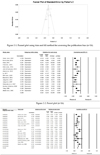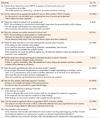Studies Included in Meta-Analysis
A1. Altiok M, Yilmaz M, Onal P, Akturk F, Temel GO. Relationship between activities of daily living, sleep and depression among the aged living at home. Pakistan Journal of Medical Sciences. 2012;28(1):162-6.
A2. Bozo, Ö, Toksabay NE, Kürüm O. Activities of daily living, depression, and social support among elderly Turkish people. The Journal of Psychology. 2009;143(2):193-206. https://doi.org/10.3200/JRLP.143.2.193-206
A3. Chao S-F. Functional disability and depressive symptoms: longitudinal effects of activity restriction, perceived stress, and social support. Aging & Mental Health. 2014;18(6):767-76. https://doi.org/10.1080/13607863.2013.878308
A4. Gardner DK, Helmes E. Interpersonal dependency in older adults and the risks of developing mood and mobility problems when receiving care at home. Aging & Mental Health. 2006;10(1):63-8. https://doi.org/10.1080/13607860500307522
A5. Gitlin LN, Szanton SL, Huang J, Roth DL. Factors mediating the effects of a depression intervention on functional disability in older African Americans. Journal of the American Geriatric Society. 2014;62(12):2280-7. https://doi.org/10.1111/jgs.13156
A6. Imai H, Yamanaka G, Ishimoto Y, Kimura Y, Fukutomi E, Chen W, et al. Factor structures of a Japanese version of the Geriatric Depression Scale and its correlation with the quality of life and functional ability. Psychiatry Research. 2014;215(2): 460-5. https://doi.org/10.1016/j.psychres.2013.12.015
A7. Jahn DR, Cukrowicz KC. Self-rated health as a moderator of the relation between functional impairment and depressive symptoms in older adults. Aging & Mental health. 2012;16(3): 281-7. https://doi.org/10.1080/13607863.2011.598847
A8. Jang Y, Bergman E, Schonfeld L, Molinari V. The mediating role of health perceptions in the relation between physical and mental health: a study of older residents in assisted living facilities. Journal of Aging and Health. 2007;19(3):439-52. https://doi.org/10.1177/0898264307300969
A9. Jang Y, Chiriboga DA, Herrera JR, Schonfeld L. Correlates of depressive symptoms among Hispanic older adults living in public housing. Journal of Applied Gerontology. 2010;29(2): 180-95. https://doi.org/10.1177/0733464809339592
A10. Kim BJ, Choi Y. The relationship between activities of daily living (ADL), chronic diseases, and depression among older Korean immigrants. Educational gerontology. 2015;41(6):417-27. https://doi.org/10.1080/03601277.2014.982006
A11. Lu L. Leisure experiences and depressive symptoms among Chinese older people: a national survey in Taiwan. Educational Gerontology. 2011;37(9):753-71. https://doi.org/10.1080/03601271003744632
A12. Shin KR, Kang Y, Kim MY, Jung D, Kim JS, Hong CM, et al. Impact of depression and activities of daily living on the fear of falling in Korean community-dwelling elderly. Nursing & Health sciences. 2010;12(4):493-8. https://doi.org/10.1111/j.1442-2018.2010.00567.x
A13. Steele JC, Patrick JH, Goins RT, Brown DK. Self-rated health among vulnerable older adults in rural Appalachia. Journal of Rural Health. 2005;21(2):182-6. https://doi.org/10.1111/j.1748-0361.2005.tb00080.x
A14. Unsar S, Dindar I, Kurt S. Activities of daily living, quality of life, social support and depression levels of elderly individuals in Turkish society. Journal of the Pakistan Medical Association. 2015;65(6):642-6.
A15.Watanabe Y, Kaneko F, Hanaoka H, Okamura H. Depression and associated factors in residents of a health care institution for the elderly. Physical & Occupational Therapy In Geriatrics. 2007;26(1):29-41. https://doi.org/10.1080/J148v26n01_03
A16. Yang Y. How does functional disability affect depressive symptoms in late life? The role of perceived social support and psychological resources. Journal of Health and Social Behavior. 2006;47(4):355-72. https://doi.org/10.1177/002214650604700404






 PDF
PDF ePub
ePub Citation
Citation Print
Print







 XML Download
XML Download